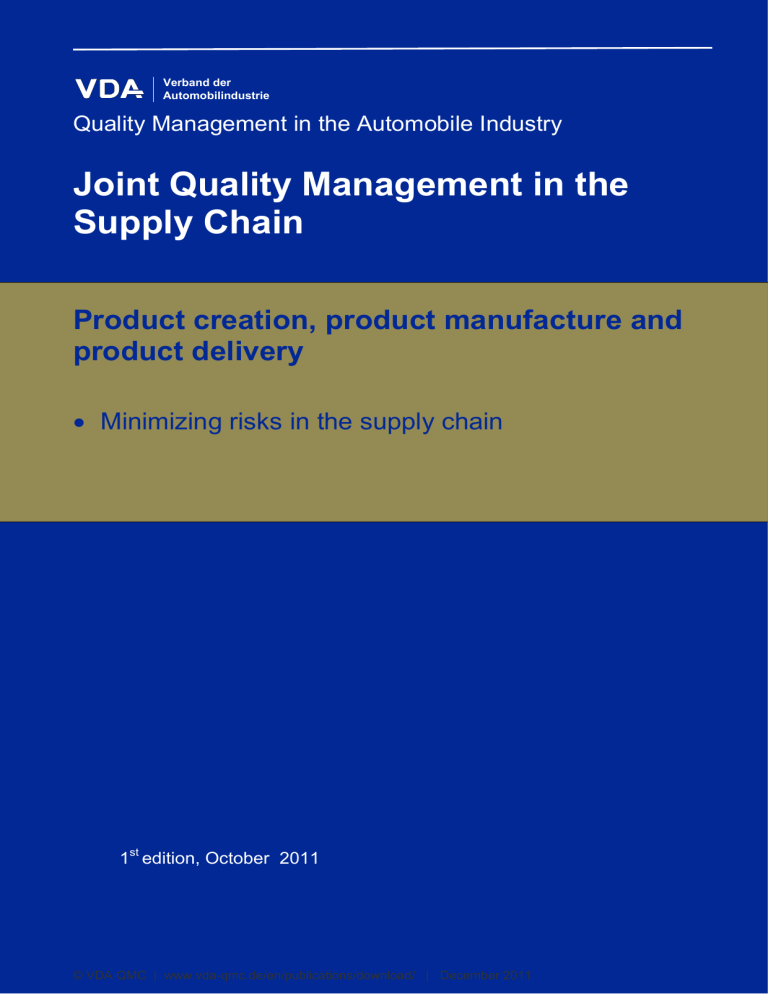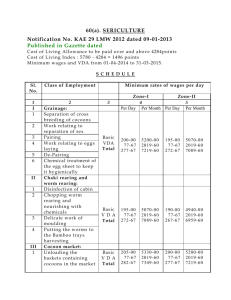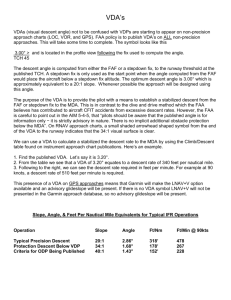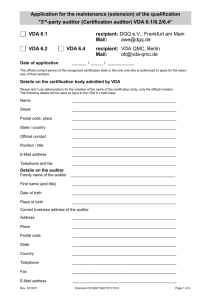
Verband der Automobilindustrie Quality Management in the Automobile Industry Joint Quality Management in the Supply Chain Product creation, product manufacture and product delivery • Minimizing risks in the supply chain 1st edition, October 2011 © VDA QMC | www.vda-qmc.de/en/publications/download/ | December 2011 Non-committal VDA recommendation regarding standards The Verband der Automobilindustrie (Automotive Industry Association - VDA) proposes that its members apply the following recommendations regarding standards when establishing and maintaining QM systems. Exclusion of responsibility This VDA document is a recommendation which is free for anyone to use. Anyone using it must ensure that it is applied correctly to each individual case. This VDA document takes account of the latest state of technology at the time it is issued. The application of the VDA recommendations does not in any way relieve the user of his own responsibility for the use of the document. To this extent, the user applies the document at his own risk. The VDA and those involved in drawing up the VDA recommendations decline all liability in any circumstances. Anyone using these VDA recommendations detecting incorrect information or the possibility of an incorrect application is asked to advise the VDA without delay, so that any deficiencies can be eliminated. References to standards The individual standards referred to by their DIN number and their dates of issue are quoted with the permission of the DIN (German Standards Institute). It is essential to use the latest issue of the standards, which are available from Beuth Verlag GmbH, 10772 Berlin, Germany. Copyright This document is protected by copyright. Its use outside the strict limits of the copyright law without the permission of the VDA is prohibited and is punishable by law. This applies in particular with regard to copying, translating, micro-filming and storage and processing in electronic systems. Translations This document will also appear in other languages. Please contact the VDAQMC for the latest position. 2 © VDA QMC | www.vda-qmc.de/en/publications/download/ | December 2011 We thank the participating organisations and their employees for their contributions in the compilation of this document. The following companies were involved in drawing up the volume: Audi AG Benteler Automobiltechnik GmbH Robert Bosch GmbH Daimler AG Adam Opel AG Dr. Ing. h. c. F. Porsche AG Volkswagen AG ZF Friedrichshafen AG Our thanks also go to all who have given us encouragement and assistance in generating and improving the document. Berlin, October 2011 VERBAND DER AUTOMOBILINDUSTRIE E.V. (VDA) 3 © VDA QMC | www.vda-qmc.de/en/publications/download/ | December 2011 Reference is made principally to the following VDA publications: Maturity level assurance for new parts – Product creation Product creation – Maturity level assurance for new parts 2nd revised edition, October 2009 Robust production process – Product manufacture Product manufacturing and delivery – Robust production process 1st edition, November 2007 Volume 6 Part 3 Volume 6 Part 3: Process audit 2nd completely revised edition, June 2010 4 © VDA QMC | www.vda-qmc.de/en/publications/download/ | December 2011 Contents Page 1 Initial situation 6 2 Objective 6 3 Premises 7 4 Guidelines for minimizing risks in the supply chain 8 4.1 Overall model 8 4.2 Using the guideline in the product creation process 10 4.3 Using the guideline when transferring from the product creation process into production 12 4.4 Using the guideline in production 15 5 Additional VDA publications covering quality assurance in the supply chain 18 6 Contact details 19 7 Appendix 20 7.1 Maturity level indicators and measurement features with significant relevance to the minimization of risks 20 Glossary and abbreviations 22 8 Imprint 23 5 © VDA QMC | www.vda-qmc.de/en/publications/download/ | December 2011 1 Initial situation Quality problems cost money and damage the image of the automobile industry – this applies to the whole value creation process and supply network, from the OEM down to the raw material supplier. The task of filtering out and combating quality risks in the entire supply chain can be achieved only by manufacturers and suppliers working together, in a cross-manufacturer system for quality and risk management. This guideline: "Minimizing risks in the supply chain" supports joint operations in the customer-supplier relationship in the supply chain. Significant motives for this guideline document on the part of the automobile manufacturers and their suppliers were: • Increasing complexity in the supply chain • Globalisation of supply markets and the accompanying increase of quality risks in the supply chain • Up to 40% of field returns caused by problems in the supply chain before the Tier 1 supplier • A drop in the qualification levels of employees in the lower links of the supply chain 2 Objective The objective of this guideline is to describe a procedure for the preventive detection and elimination of quality risks in the entire value creation chain of automobile development and manufacture. In this, major reference is made to existing methods used in the German automobile industry (VDA). 6 © VDA QMC | www.vda-qmc.de/en/publications/download/ | December 2011 3 Premises This guideline is based on the following premises: • The agreed, direct contract between the customer and supplier applies, together with the defined responsibilities (risk elimination in the PEP – product creation process – and production) • Responsibility for detecting and preventing possible quality risks lies with each supplier responsible for his products and processes in the onward supply chain (Tier n) • The information obtained in the course of joint activities to minimize risks is treated as confidential These factors form the basis for: • Cooperation as partners in the supply chain, based on trust, transparency and dependability • An extension of active and constructive supplier management into the lower links of the supply chain (beyond Tier 2 suppliers) • Intensified use of existing, proven VDA tools and methods This document does not examine the following: • • • • Financial risks Changes in legislation The political, social environment Peripheral geographic conditions 7 © VDA QMC | www.vda-qmc.de/en/publications/download/ | December 2011 4 Guidelines for minimizing risks in the supply chain 4.1 Overall model Fig. 4.1.1: Overall model for minimizing risks – broken down into phases Minimizing risks is carried out in three sequential time-phases in the automobile development and manufacture: • In the product creation process (development / project) • At the transfer from project to production • In production (full production / logistics) In this – in addition to close cooperation between customer and supplier – cross-functional cooperation between development, production, logistics, purchasing and quality is essential. 8 © VDA QMC | www.vda-qmc.de/en/publications/download/ | December 2011 Fig. 4.1.2: Navigator for minimizing risks, using existing VDA methods Depending on the phase a specific procedure is used, which is described in the following sub-sections. Major reference is made to the following VDA publications: • VDA publication "Product creation – Maturity level assurance for new parts", 2nd revised edition, October 2009 • VDA publication "Product manufacture and delivery – Robust production process", 1st edition, November 2007 Significant factors for the successful minimization of risks are: • The comprehensive and considered application of elements to minimize risks in the process, from the development phase, through production launch and into full production • The transfer of the procedures into the lower links in the supply chain not merely to the OEM / Tier 1 level. 9 © VDA QMC | www.vda-qmc.de/en/publications/download/ | December 2011 4.2 Using the guideline in the product creation process The procedure for minimizing risks in the development phase is specified jointly by the customers and suppliers. Based on the VDA standard "Maturity level assurance in the supply chain" the following steps are recommended: Fig. 4.2.1: Overview – Minimizing risks in the product creation process Notes regarding measurement criteria and questions refer to the VDA publication quoted. As a minimum, the use of this guideline is recommended: • For products with an identified "A" risk • Along the critical path The central element in minimizing risks is the identification of the “critical path" in the supply chain (system, component, part). 10 © VDA QMC | www.vda-qmc.de/en/publications/download/ | December 2011 Fig. 4.2.2.: Supplier management – specifying the critical paths (source: VDA publication "Maturity level assurance for new parts", 2nd edition, 2009) Independent of the customers' requirements, any supplier can specify the critical path in his onward supply chain in cooperation with his subsupplier and apply the principles of maturity level assurance in accordance with the VDA publication by reference to the identified risks. Fig. 4.2.3.: Sub-supplier management – specifying the critical paths (source: VDA publication "Maturity level assurance for new parts", 2nd edition, 2009) No matter what the method selected, risk identification and, if appropriate, minimizing risks must be applied in the supply chain. 11 © VDA QMC | www.vda-qmc.de/en/publications/download/ | December 2011 4.3 Using the guideline when transferring from the product creation process into production For a comprehensive concept for minimizing risks it is essential to transfer the experience gained in the development phase into the production phase. In this process, it is important that no vacuum occurs regarding responsibility. It must also be ensured that no important information is lost. In the course of the transfer, MLA (Maturity level assurance) is used to address any questions, particularly regarding the status of the ABC risk analysis and also the critical path and the status of the MLA measurement criteria. The procedure is described in the following steps: Fig. 4.3.1: Overview: minimizing risks in the transfer from the product creation process to production The following points must be ensured: • The production process and product release must be fully and successfully completed • Deviations from agreed performance levels (particularly regarding quality and capacity) must be communicated between supplier and customer • Responsibilities for production must be clearly specified and any changes in responsibilities must be communicated to the customer. 12 © VDA QMC | www.vda-qmc.de/en/publications/download/ | December 2011 Transfer criteria are specified on the basis of the following list of questions: Fig. 4.3.2: Transfer criteria 13 © VDA QMC | www.vda-qmc.de/en/publications/download/ | December 2011 Further information on the transfer is provided in the VDA publications: • Maturity level assurance for new parts: ML 7 (Project closure;, transfer of responsibility to production; start requalification), Section 5.2.VIII • Robust production processes: check-point, Sections 4 and 7.2.4 The sequence of the transfer is organised as follows: Fig. 4.3.3: Organising the transfer process The transfer can take place in two ways: • Complete transfer at fixed point in time The transfer takes place when all outstanding points from the development project have been cleared completely. Only then is the project team discharged. • The transfer takes place as a process over a period The transfer takes place in successive stages to the departments responsible for production and is completed only when all the various points have been cleared and responsibilities have been allocated in production. 14 © VDA QMC | www.vda-qmc.de/en/publications/download/ | December 2011 4.4 Using the guideline in production In addition to the risks already detected in the product creation and transfer processes, the new identified risks in the production phase are taken into consideration by the relevant departments. Notes on identifying risks in production are provided in the VDA publication "Robust production process". In this connection the following activities are required: Fig. 4.4.1: Overview – minimizing risks in production Critical path: Tracking the critical paths is carried out in the same way as the procedure in the project phase. Audits / supplier visits: Regular visits to the relevant supplier are essential in order to detect potential risks in the supply chain at an early stage. 15 © VDA QMC | www.vda-qmc.de/en/publications/download/ | December 2011 Criteria for planning supplier visits / audits are: Fig. 4.4.2: Systematic arrangements for frequency of visits – examples of criteria for audits / supplier visits in the supply chain Sub-supplier management: As a further measure, systematic sub-supplier management should be operated. Essential features in this regard are described in the VDA publication "Robust production process", Section 5.2, page 72. The intensity and frequency of the proposed methods will depend on the risk which has been identified. 16 © VDA QMC | www.vda-qmc.de/en/publications/download/ | December 2011 Possible risk indicators are: Fig. 4.4.3: Risk indicators in production 17 © VDA QMC | www.vda-qmc.de/en/publications/download/ | December 2011 5 Additional VDA publications covering quality assurance in the supply chain In recent years a series of new VDA tools and methods has been developed, which inter-act to make a significant contribution to minimizing risks in the supply chain. Fig. 5.1 shows these in their relation to the individual phases in the value creation chain. Fig. 5.1: Additional VDA publications covering quality assurance in the supply chain As the central and cross-functional tool for maturity level management, the VDA publication "Maturity level assurance" (MLA) is expanded by the use of the VDA standards shown in Fig. 5.1, as the project progresses from the award of the contract to the transfer of responsibility to production, depending on the risks currently identified. The requirements for robust production processes are also established in this phase. The VDA publication "Robust production process" (RPP) is the core description for ensuring stable processes from SOP (start of production) to EOP (end of production). This document is supported by the use of other VDA standards listed in Fig. 5.1, as well as company-specific supplier management procedures. 18 © VDA QMC | www.vda-qmc.de/en/publications/download/ | December 2011 6 Contact details The VDA QMC will be pleased to provide further information on "Minimizing risks in the supply chain". Your contact is: Heinz-Günter Plegniere VDA QMC Quality Management Center in VDA (Verband der Automobilindustrie e.V,/ German Association of the Automotive Industry) Behrenstraße 35 10117 Berlin Germany Central tel.: Central fax: +49 (0) 30 / 89 78 42 - 0 +49 (0) 30 / 89 78 42 - 605 Central e-mail: info@vda-qmc.de 19 © VDA QMC | www.vda-qmc.de/en/publications/download/ | December 2011 7 Appendix 7.1 Maturity level indicators and measurement features with significant relevance to the minimization of risks 20 © VDA QMC | www.vda-qmc.de/en/publications/download/ | December 2011 21 © VDA QMC | www.vda-qmc.de/en/publications/download/ | December 2011 8 Glossary and abbreviations Term Definition "A" risk parts Items supplied (systems, assemblies, parts) which have been assessed to the VDA standard for Maturity level assurance and have been classified as having a high risk ABC risk assessment Classification (prioritization) by the customer of a supply item at the beginning of a project into one of 3 levels: - A (high maturity level risk) - B (medium maturity level risk) - C (low maturity level risk) which determine the intensity of cooperation in the supply chain. For further details, see the VDA publication "Maturity level assurance for new parts", 2nd edition, October 2009, sections 2.2.1 and 2.2.2. COP Conformity of production ML Maturity level MLA Maturity level assurance (abbreviation covering the VDA publication "Maturity level assurance for new parts" Supplier set assessment Procedure for the preliminary selection of suppliers for an item to be supplied REQ Requalification RED themes Maturity level criteria which have been assessed with the traffic colour RED. For further details, see the VDA publication "Maturity level assurance for new parts", 2nd edition, October 2009, section 3.4.2. RPP Robust production process (abbreviation covering the VDA publication "Robust production process") Sub-supplier management Planning, assessment, monitoring and control of the influencing factors which are determined by sub-suppliers, production materials and services with an effect on quality. (based on the VDA publication "Robust production process", 1st edition, November 2007, section 5.2. VDA German Association of the Automotive Industry 22 © VDA QMC | www.vda-qmc.de/en/publications/download/ | December 2011 Imprint: ISSN 0943-9412 On-line document, published 10/2011 Copyright 2011 by Verband der Automobilindustrie e. V. (VDA) Quality Management Center (QMC) Behrenstraße 35 10117 Berlin Germany 23 © VDA QMC | www.vda-qmc.de/en/publications/download/ | December 2011 Verband der Automobilindustrie e. V . 24 © VDA QMC | www.vda-qmc.de/en/publications/download/ | December 2011


